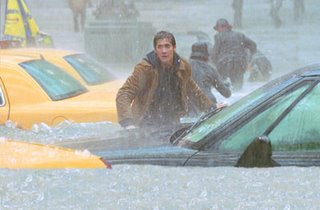Environmental Defense Ads v. Daisy
Thank you, Environmental Defense, for making these ads and for making them so easy to share. I want to make it clear that I don't think the ads are incorrect, or that Environmental Defense is wrong. It's just that the world is different than the world these ads are addressing. I would like to compare ED's ads to LBJ's famous Daisy Ad.

The rhetoric of all three ads is similar: we are responsible for our children. The fear (horror, really) of these ads is that we as a people will be stupid enough to allow these shining faces to be obliterated or face certain catastrophe. And all three ads are equally effective on the horror-meter. I like the fact that ED's ads are focusing on children's faces and not glaciers. This is localizing and making climate change relevant to what's in front of you. And I like that they don't try to explain climate change. You don't need to explain climate change any more than you need to explain nuclear fusion, or for that matter how your computer works. Its the results that matter--we live in a culture accustomed to trusting science. It has been bugging the crap out of me for years that Big Oil Power shifted the focus onto how climate change works in order to obfuscate the situation.
The problem I have is with the culture that is consuming these ads, and their respective contexts. LBJ's Daisy Ad had a forceful leader (well, kind of) behind it. The whole reason the Daisy ad works so well is because LBJ is the inferred Daddy who will take the little girl and keep her safe because he is big and strong and in control and sane and will not use the bomb. It's a closed circuit. Without a closed circuit like this, what does the horror do?
Environmental Defense's ads are not grounded in a larger leadership, and so are, IMO, existentially dangerous. I am left wondering what I, viewer, is supposed to do about all this. Turn off my lights? Use flourescent bulbs? Make my errands more efficient? The scale feels all wrong, and the scale shift is too abrupt. There is something so strange about being told that the world of my children will be apocalyptic if I don't spend five minutes thinking about my energy consumption every day. It's so small, so easy not to do. And it is too weird because you look around and see everybody else not doing it. Why should I feel guilty about driving when the roads are clogged anyway? My truck makes very little difference in the big scheme of things.
The problem with these ads is that they function in a world without any leadership. There is no LBJ who will protect us from hurricanes and malaria and warmongering. For that matter, there isn't even a company bus shuttling folks from the exurbs using natural gas or electricity. I see the logic behind showing folks that their consumption matters, and FWIW, I turn off my lights and drive as little as possible. But where's the support? Where's the enforcement? Where's the structure that makes all these personal choices part of a larger whole?
Children model behaviors that adults do, and adults model behaviors that their leaders and community members do. We are not particularly autonomous--we are social creatures. Unfortunately we live in a culture that thinks otherwise. We are doing all this bowling alone and can do everything from home and increasingly turn inward. This is a very powerless position to be in.
What if every single ad campaign was strapped to a larger community action? What if rich people were asked to donate scads of cash and solar power companies were asked to do demos and promote themselves and do in-kind donations? What if ads like these were local, and harnessed to specific action-based programs that provide community-based structure?
Let me be specific:
Say Environmental Defense goes to Salinas California, which is an exurb of San Jose and farming community. And after a small, inexpensive grassroots team defines the specific CO2 problems of Salinas: no good public transportation options to San Jose, maybe, no infrastructure for carpooling and lots of people leaving lots of lights on because of crime. Then lots of money can flow into Salinas to fix these problems grassroots style. Ads like Train and Tick can be harnessed to commuter busses and the creation of a carpooling message board. Maybe there's an inexpensive solar-powered light that can be given away or sold very cheaply in the neighborhoods that have crime problems. Or motion-sensors! Motion sensors cost nothing, and volunteers could go door to door giving them away and helping install them!
Net result: One community gets to be virtuous in a way that makes some sense. CO2 emissions go down. Awareness is raised, and fear is used in a way that is existentially fair. This structure of solutions is strong and provides moral support. It is easy to shame the folks who refuse to carpool in a community where there is lots of public support for transportation alternatives. Shame and fear both stop being bullshit tactics and start actually working when there is an armature in place.
I don't advocate whining about the Bush administration. I do advocate providing a strong, active counterpoint that does more than throw scares into people.























